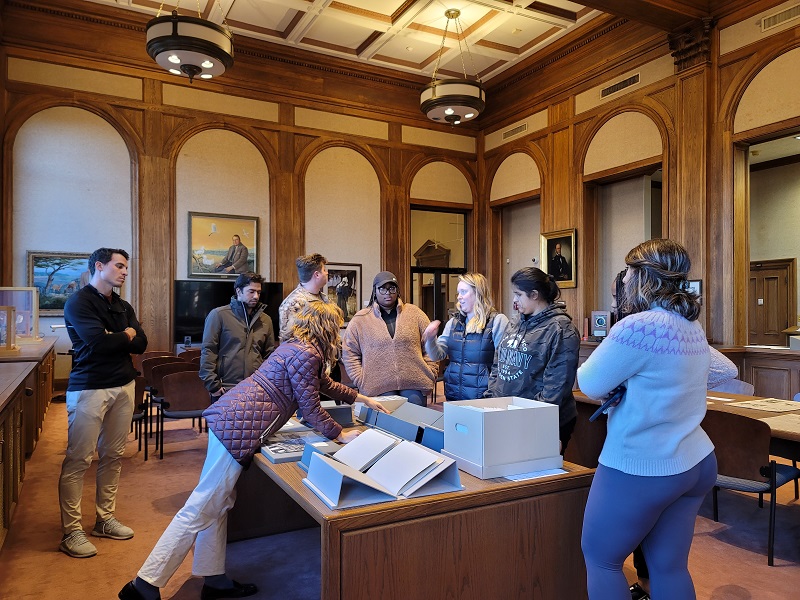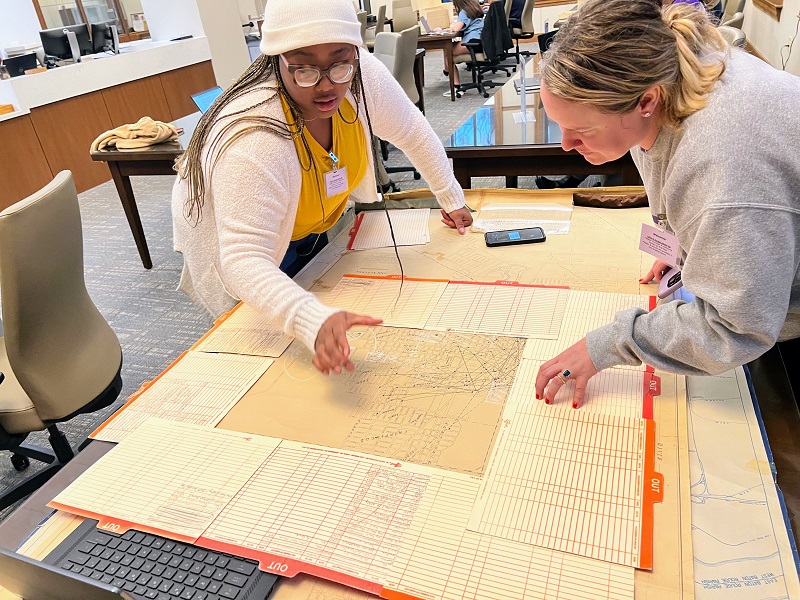Fabio Capra-Ribeiro, Assistant Professor of Architecture and LSU Libraries Special Collections Faculty Fellow, collaborated with LSU archivists, librarians, and other fellows to develop archives-centered curriculum. The multi-faceted support of the fellowship enabled Capra-Ribeiro to conceptualize a special collections research project for his Graduate Design Studio, “Urban Renewal Catalysts: Architectural Strategies to Pursue Spatial Equity.”
 Leah Duncan describes items from the ExxonMobil Baton Rouge Historic Collection. Students, from left to right: Morgan Mills, Masood Koochaki, Joseph Schwartzenburg, McKenzie McDavid, Toska Gamble, Sadia Shatyi, Adrianna Jordan, and Sanaz Salajegheh
Leah Duncan describes items from the ExxonMobil Baton Rouge Historic Collection. Students, from left to right: Morgan Mills, Masood Koochaki, Joseph Schwartzenburg, McKenzie McDavid, Toska Gamble, Sadia Shatyi, Adrianna Jordan, and Sanaz Salajegheh Architecture students McKenzie McDavid and Toska Gamble examine the 1936 “Intra-Urban Migration: Baton Rouge” maps, from the L. J. Voorhies Blueprints Collection.
Architecture students McKenzie McDavid and Toska Gamble examine the 1936 “Intra-Urban Migration: Baton Rouge” maps, from the L. J. Voorhies Blueprints Collection.
This spring, Capra-Ribeiro implemented the project, tasking his master's in architecture students with pursuing archival research about North Baton Rouge and presenting their findings in a short video. Before the course began, Capra-Ribeiro worked with Leah Wood Jewett, LSU Special Collections Exhibitions Manager, to select collections representing North Baton Rouge. During the course, Leah Duncan, Digital Engagement and Educational Services Librarian, guided students in developing necessary archival research knowledge. At the project's end, students exhibited their videos in the Clark and Laura Boyce Gallery in Julian T. White Hall.
Students in Capra-Ribeiro's design studio reflected that the project allowed them to practice new skills, especially the ability to engage in an ongoing discovery process.
Students also appreciated the opportunity to engage with primary sources, citing their use of historic maps, ephemera published by Baton Rouge non-profits, and neighborhood newspapers.
 McKenzie McDavid speaks to students visiting the final exhibit in the Clark and Laura Boyce Gallery in Julian T. White Hall.
McKenzie McDavid speaks to students visiting the final exhibit in the Clark and Laura Boyce Gallery in Julian T. White Hall.
However, the architecture students gained insight that surpassed practical research skills; they explained that encountering archival materials sparked a personal connection with their topics and led them to recognize their responsibility to help communities flourish. McKenzie McDavid said that engaging with archival materials helps future architects understand the history of a space and “better connect to the feel of ‘what was.’” Morgan Mills shared that the experience made him feel a sense of “kinship” with past architects and led him to realize that “any desire to solve some social, spatial, or civic issue needs to [involve] researching accounts of people who have been working on those same issues in previous decades.”
LSU Libraries Special Collections looks forward to fostering new learning experiences with our second year of the Special Collections Faculty Fellowship. The program is designed to enable digitally engaged and archive-centered teaching across campus by providing hands-on workshops, ongoing guidance and support from Libraries’ partners, and access to archival collections and digital tools. LSU teaching faculty members are invited to apply on the Special Collections website.
The LSU Libraries includes the LSU Library and the adjacent Hill Memorial Library. Together, the libraries contain more than 4 million volumes and provide additional resources such as expert staff, technology, services, electronic resources, and facilities that advance research, teaching, and learning across every discipline.